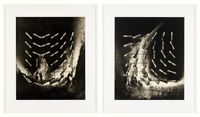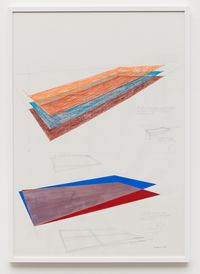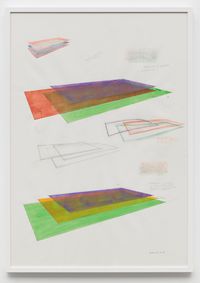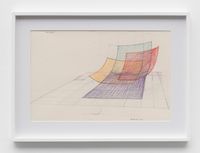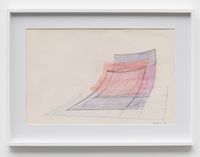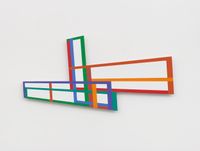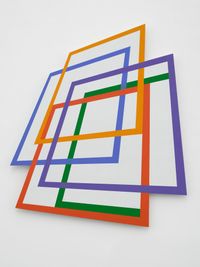In her conceptual and multi-dimensional practice, Dóra Maurer focuses on themes of change and displacement. Incorporating painting, drawing, printmaking, photography and filmmaking, her approach can encompass process-based experiment, formal investigations of rule-based compositional logic and geometric abstraction.
Read MoreBorn in Budapest in 1937, Maurer trained as a graphic artist during the late 1950s, eventually settling between Vienna and Budapest from 1967 onwards following her marriage to the Austro-Hungarian artist Tibor Gayor. A prominent figure in the Hungarian neo-avant garde, Maurer was, unusually for the time, able to work both inside and outside of due to Gayor's dual citizenship. This unique position, between 'East' and 'West', enabled her to develop a particular artistic language, a 'self-made system' that, over the past fifty years, she has continually renewed: 'I was interested neither in conceptual art itself, nor in its established rules. The heuristic experience of movement and change became the basis of my mode of survival in the late Sixties, both from a personal and artistic standpoint', she has said.
Maurer's early work, made during the 1970s—a key period in her career—included black and white photography, structural film and process-based drawing often featuring incremental change through repetition and minimal visual means. In the photographic series 'Reversible and Changeable Phases of Movements' (1972), for example, simple actions such as throwing and catching a ball, making hand signs or different facial expressions are played out cinematically across a series of images presented in grid formation. Seriality runs throughout Maurer's work, first appearing as early as 1968—70 with the work Displacements and later in the '4 out of 5' series (1976—79), 'Hidden Structures' (1977—80) and the 'Square versus Rectangle' photograms (1979). A key work from this period, entitled Seven Turns (1977—78), uses similar methods to enact a visual and cognitive exercise, whereby the artist holds a piece of blank paper in front of her face turned at a 45 degree angle, photographs it and then repeats the process seven times with each subsequent image. Resulting in a final kaleidoscopic image, the whole registers both pictorial transformation and photographic memory through one basic, performative gesture.
In her shaped, colourful, abstract painting, Maurer focuses on the interplay between internal and external spatial factors, often inferring the mathematical concept of a 'magic square': a form enclosing a consistent volume, which can be multiplied and used as the basis for a composition. These ideas are made manifest in one of her most celebrated works, a permanent wall painting installed in an irregularly shaped tower room at Castle Buchberg am Kamp in Austria in 1982.
While the Buchberg installation marked the beginning of a move into painting, Maurer asserts that it was in fact her early filmmaking that led her to explore the relationship between colour and light, a subject that continues to guide her practice to this day. Focusing on the effects of colour and the idea of transformation through superimposition, Maurer's paintings create a semblance of sculptural plasticity, appearing to hover in space, while in fact existing on a single plane.
In the 'Overlapping' series, two planes of intersecting colour in the form of two distorted squares appear curved or foreshortened, as if stretched onto a spherical surface, while in the 'Quod Libet' series, the more linear forms of rectangular or square frames of colour are overlaid and set at an angle to create a dramatically three-dimensional effect. More recently, in the 'IXEK' series, whose title refers to the Hungarian word for the plural of the letter 'x', Maurer uses two or three fields of intersecting colour, loosely forming an 'x'. Working with the limits of human perception and how this is shaped and effected by colour, the forms appear in constant flux: 'I make experiments, I change methods without restraint, and I think in formal oppositions' she has stated.
Dóra Maurer studied at the Hungarian Academy of Fine Arts between 1955 and 1961. Widely acknowledged as one of the most important members of the Hungarian avant-garde, throughout her career she has been a keen promoter of young artists. Maurer has exhibited extensively, most recently at Tate Modern, London (2019); Museum of Modern Art, New York (2015, 1985); Whitechapel Gallery, London (2015); Museum Ritter, Germany (2014); The Museum of Fine Arts, Houston, Texas (2014); 12th International Biennial, Istanbul (2012); Ludwig Museum, Budapest (2012, 2008, 1997); and Centre Pompidou, Paris (2010). Her work is held in collections across the world, including Museum of Modern Art, New York; Tate Modern, London; Art Institute of Chicago; Hungarian National Gallery, Budapest; Neue Nationalgalerie, Berlin; and Victoria & Albert Museum, London.
Text courtesy White Cube.

